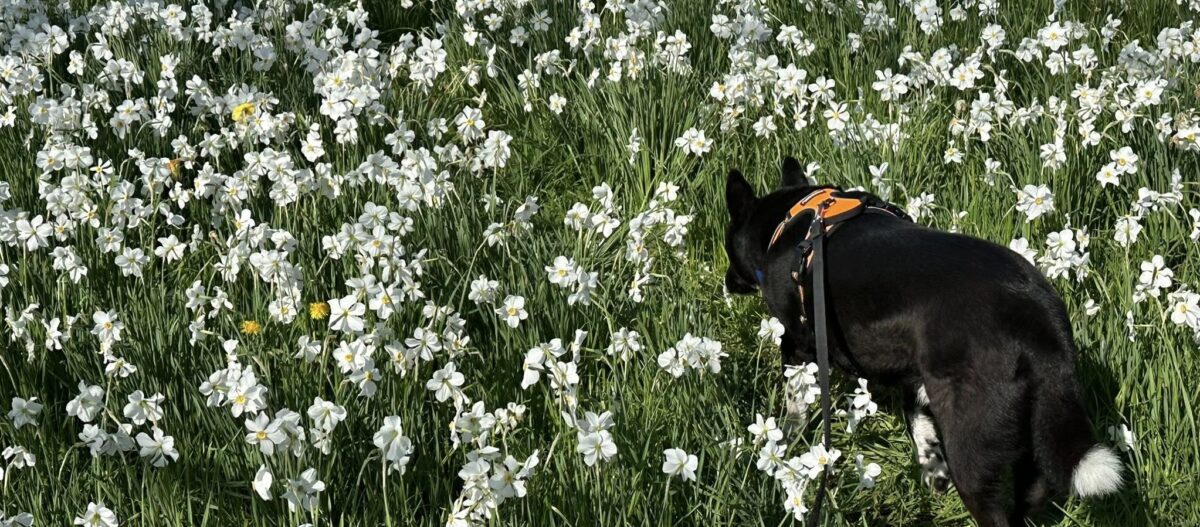Last night we took a walk up on the hill behind This Old House.
There was a light rain and some gusty wind,
with the most unusal golden light sky – just beautiful.
Shortly after the rainfall, up over the house…
was this.. a double rainbow
I could see most of the rainbow’s arch, but it was very hard to capture all of it in one frame…
Can you see the double rainbow ring below?
* Author Donald Ahrens in his text Meteorology Today describes a rainbow as “one of the most spectacular light shows observed on earth”. Indeed the traditional rainbow is sunlight spread out into its spectrum of colors and diverted to the eye of the observer by water droplets.
* The traditional description of the rainbow is that it is made up of seven colors – red, orange, yellow, green, blue, indigo, and violet. Actually, the rainbow is a whole continuum of colors from red to violet and even beyond the colors that the eye can see.
The colors of the rainbow arise from two basic facts:
Sunlight is made up of the whole range of colors that the eye can detect. The range of sunlight colors, when combined, looks white to the eye. This property of sunlight was first demonstrated by Sir Isaac Newton in 1666.
Light of different colors is refracted by different amounts when it passes from one medium (air, for example) into another (water or glass, for example).
*Sometimes we see two rainbows at once, what causes this? We have followed the path of a ray of sunlight as it enters and is reflected inside the raindrop. But not all of the energy of the ray escapes the raindrop after it is reflected once. A part of the ray is reflected again and travels along inside the drop to emerge from the drop. The rainbow we normally see is called the primary rainbow and is produced by one internal reflection; the secondary rainbow arises from two internal reflections and the rays exit the drop at an angle of 50 degrees° rather than the 42°degrees for the red primary bow.
*Notice the contrast between the sky inside the arc and outside it. When one studies the refraction of sunlight on a raindrop one finds that there are many rays emerging at angles smaller than the rainbow ray, but essentially no light from single internal reflections at angles greater than this ray. Thus there is a lot of light within the bow, and very little beyond it. Because this light is a mix of all the rainbow colors, it is white. In the case of the secondary rainbow, the rainbow ray is the smallest angle and there are many rays emerging at angles greater than this one. Therefore the two bows combine to define a dark region between them – called Alexander’s Dark Band, in honor of Alexander of Aphrodisias who discussed it some 1800 years ago!


BEAUTIFUL!
Great shot with the house Karen!!!…thanks for all the info about rainbows. This picture deserves to come out of the computer and made into a 16×20 for one of your walls….maybe even larger?….You need to do this!!!! let me know when you do so I can see it!!!!
Keep up the good work!
Tim
I seriously think you should enlarge and frame the first photo. It is breath-taking!!
rainbows bring hope
Really beautiful captures! We recently had a huge double rainbow and they are just breathtaking. Interesting info about them too.
Kat
Priceless shot! Would love to have one of our house like that…
Stun-ning. I love all the shots but really like the 3rd one a lot.
Never saw a double rainbow. They seem to be rare.
There was one on the Vineyard a few weeks ago.. but that's a magical place anyway 🙂
lovely!
Yep Yepppp. Enlarge that photo and frame it! You may never get a better shot of a rainbow.
Now that is just super cool!! You have to frame it!
that first shot is a framer for sure, what a beauty! I have never saw a double rainbow, its got to be a sign for something good!!thankyou for the kind words on my blog today
Amazing!!! I love rainbows! We had lots in Charleston in the summer when we would get afternoon rains with all the heat and humidity. We have seen several here. I think they are a sign from God!
If you do blow it up on canvas, there is a website called CGPro Prints that does great canvases for cheap! I have used them a few times now with great results!
You captured them so well- what a true treat to see a double and I had no idea why they occurred like that…
WOW, that first photo is just gorgeous!
Donna.
Spectacular!! Thanks for sharing!
Good Lawd… I LOVE THE ONE WITH YOUR HOUSE BENEATH IT!
WOW!
I love rainbows!!! I stare at them till they disappear … and I don't dissect all the scientific mumbo jumbo. 🙂